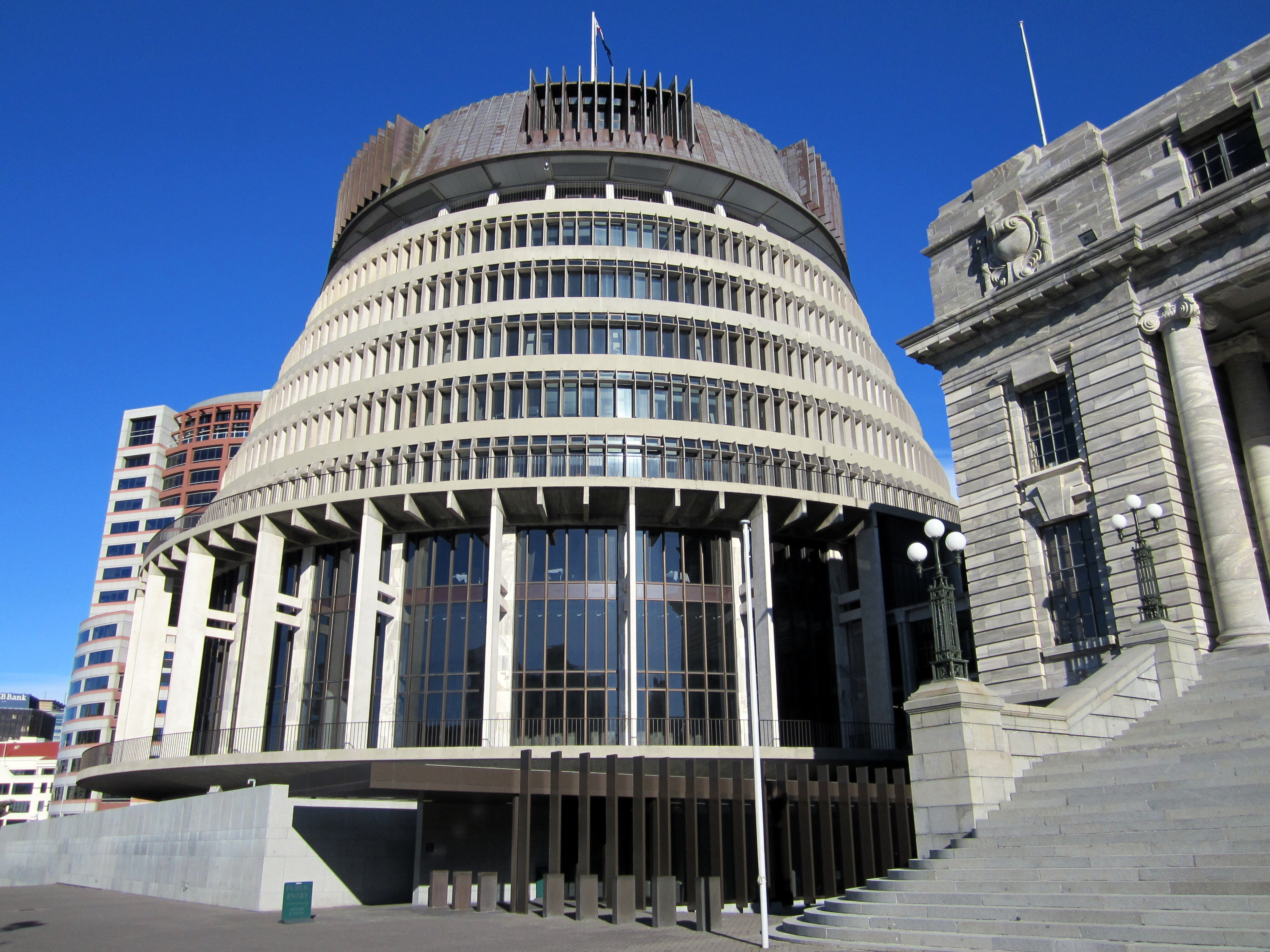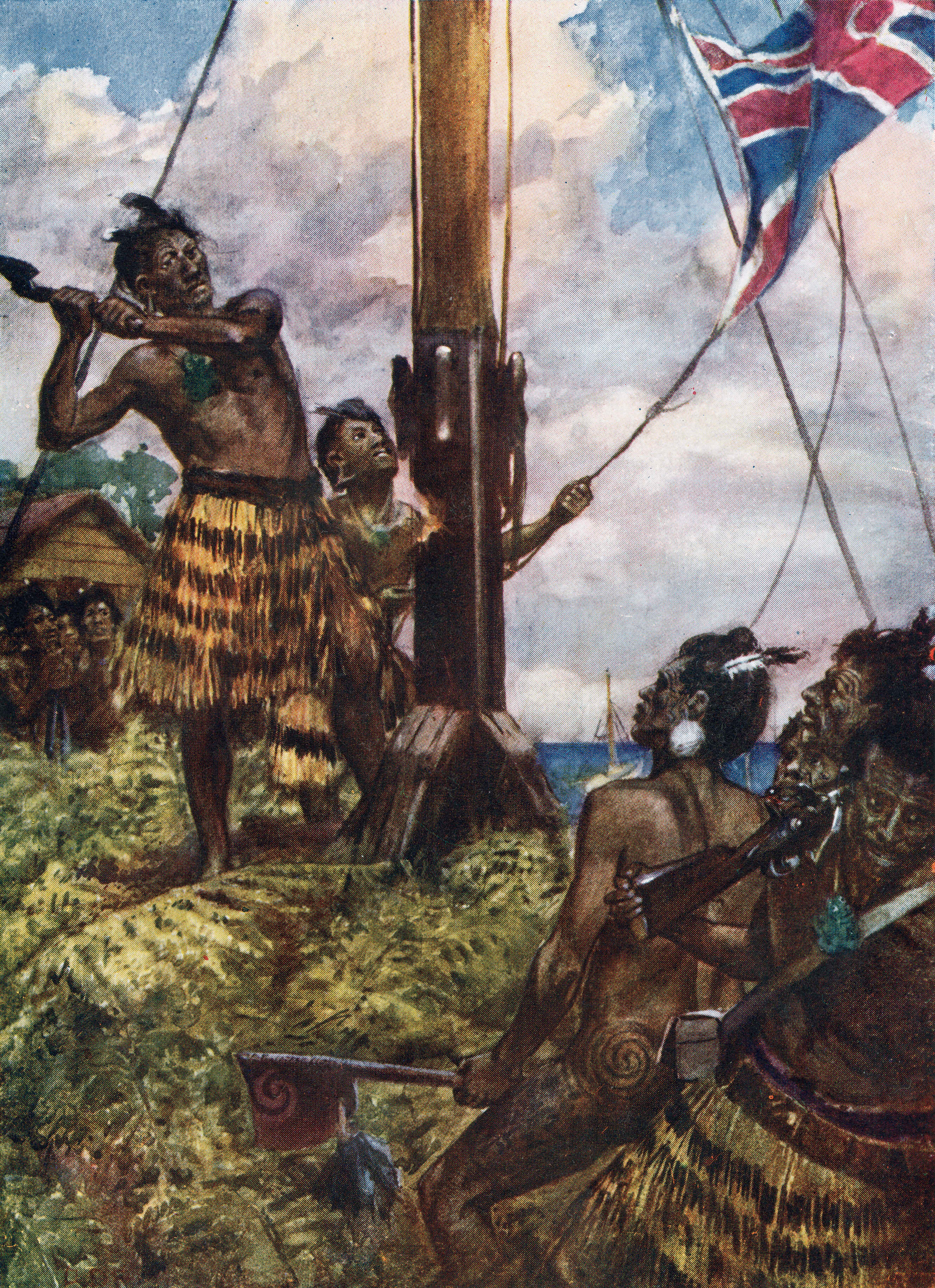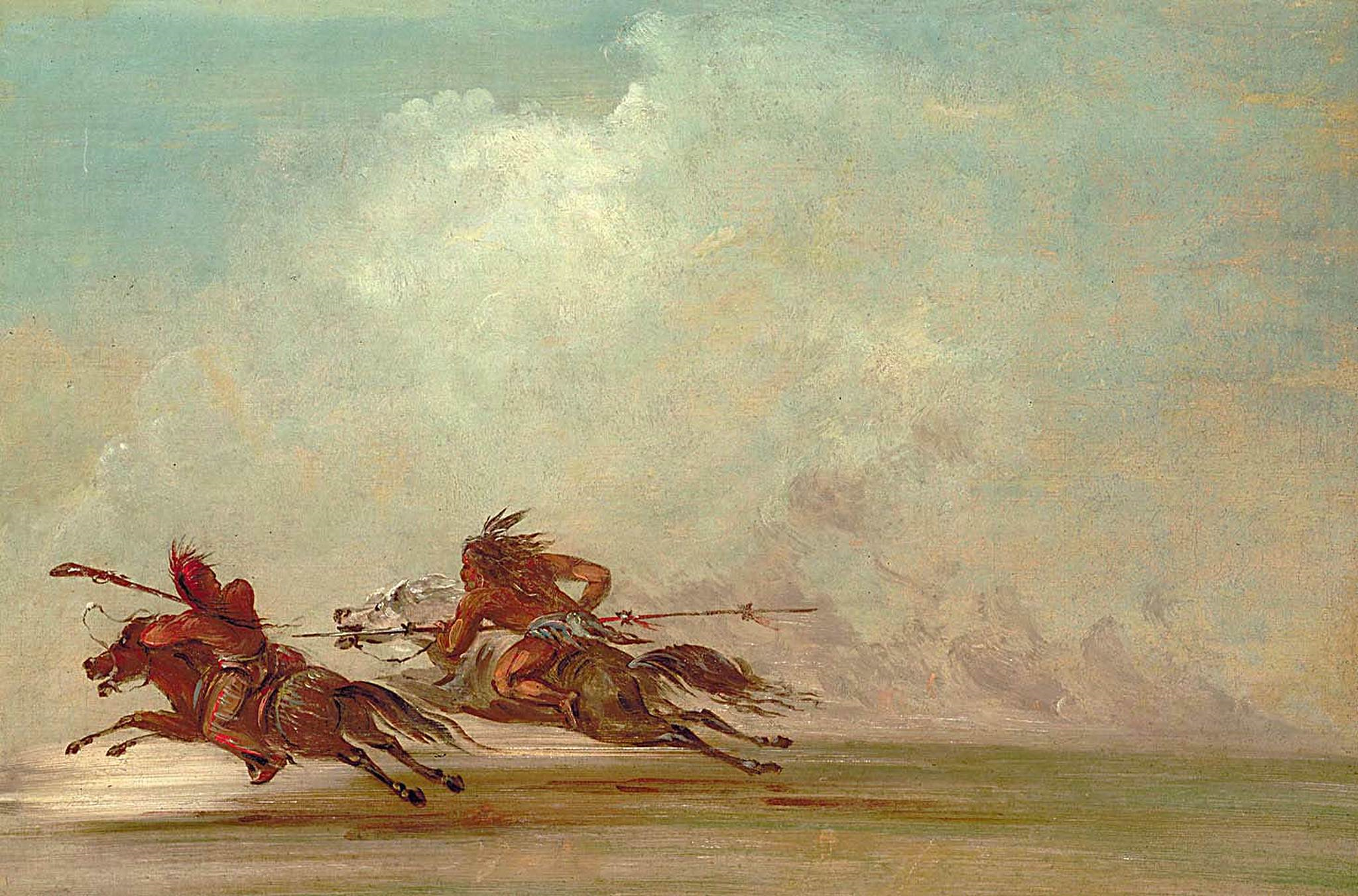|
Waikato River
The Waikato River is the longest river in New Zealand, running for through the North Island. It rises on the eastern slopes of Mount Ruapehu, joining the Tongariro River system and flowing through Lake Taupō, New Zealand's largest lake. It then drains Taupō at the lake's northeastern edge, creates the Huka Falls, and flows northwest through the Waikato Plains. It empties into the Tasman Sea south of Auckland, at Port Waikato. It gives its name to the Waikato region that surrounds the Waikato Plains. The present course of the river was largely formed about 17,000 years ago. Contributing factors were climate warming, forest being reestablished in the river headwaters and the deepening, rather than widening, of the existing river channel. The channel was gradually eroded as far up river as Piarere, leaving the old Hinuera channel through the Hinuera Gap high and dry. The remains of the old course are seen clearly at Hinuera, where the cliffs mark the ancient river edges. The Wai ... [...More Info...] [...Related Items...] OR: [Wikipedia] [Google] [Baidu] |
Hamilton, New Zealand
Hamilton (, ) is an inland city in the North Island of New Zealand. Located on the banks of the Waikato River, it is the seat and most populous city of the Waikato, Waikato region. With a territorial population of , it is the country's List of cities in New Zealand, fourth most-populous city. Encompassing a land area of about , Hamilton is part of the wider Hamilton Urban Area, which also encompasses the nearby towns of Ngāruawāhia, Te Awamutu and Cambridge, New Zealand, Cambridge. In 2020, Hamilton was awarded the title of most beautiful large city in New Zealand. Hamilton is now considered the fastest growing city in the country. The area now covered by the city began as the site of several Māori people, Māori villages, including Kirikiriroa, from which the city takes its Māori name. By the time English settlers arrived, most of these villages, which sat beside the Waikato River, were abandoned as a result of the Invasion of Waikato and New Zealand land confiscations, land ... [...More Info...] [...Related Items...] OR: [Wikipedia] [Google] [Baidu] |
An Encyclopaedia Of New Zealand
''An Encyclopaedia of New Zealand'' is an official encyclopaedia about New Zealand, published in three volumes by the New Zealand Government in 1966. Edited by Alexander Hare McLintock, the parliamentary historian, assisted by two others, it contained over 1,800 articles and 900 biographies, written by 359 contributing authors. The Government commissioned the encyclopaedia in 1959 and McLintock started work on it in mid-1960. The encyclopaedia is more comprehensive, and more representative of minorities, than previous New Zealand reference works, such as the vanity press '' The Cyclopedia of New Zealand'' published around sixty years earlier, but not as representative as the later ''Dictionary of New Zealand Biography''. A number of women were included as representing firsts, including Kate Edger. Its publication in November 1966 met with an enthusiastic response; within two months almost all of its initial print run of 34,000 copies had sold. After the last 3,000 copies sol ... [...More Info...] [...Related Items...] OR: [Wikipedia] [Google] [Baidu] |
Waikato Raupatu Claims Settlement Act 1995
The Waikato Raupatu Claims Settlement Act 1995 is an act of the New Zealand Parliament passed into law in 1995. It was the first act implementing a major historical Treaty of Waitangi settlement since the Treaty of Waitangi Act 1975 was amended in 1985 to allow the Waitangi Tribunal to investigate historic breaches of the treaty. Background The act was the culmination of years of negotiations between Waikato Tainui and the New Zealand Government. Originally, Waikato-Tainui had made a claim by way of the Waitangi Tribunal, but in 1991 direct negotiations began between the tribe and the government of Prime Minister Jim Bolger. In 1994, a Heads of Agreement was signed. The Deed of Settlement was signed on 22 May 1995 by Prime Minister Jim Bolger and Dame Te Atairangikaahu at Turangawaewae Marae. The total settlement package was $170m. Assent Royal Assent for the bill was granted by Queen Elizabeth II on 3 November 1995 in a ceremony at Government House in Wellington. Da ... [...More Info...] [...Related Items...] OR: [Wikipedia] [Google] [Baidu] |
Waitangi Tribunal
The Waitangi Tribunal (Māori: ''Te Rōpū Whakamana i te Tiriti o Waitangi'') is a New Zealand permanent commission of inquiry established under the Treaty of Waitangi Act 1975. It is charged with investigating and making recommendations on claims brought by Māori relating to actions or omissions of the Crown, in the period largely since 1840, that breach the promises made in the Treaty of Waitangi. The Tribunal is not a court of law; therefore, the Tribunal's recommendations and findings are not binding on the Crown. They are sometimes not acted on, for instance in the foreshore and seabed dispute. The inquiry process contributes to the resolution of Treaty claims and to the reconciliation of outstanding issues between Māori and Pākehā. In 2014, the Tribunal found that Ngāpuhi rangatira did not give up their sovereignty when they signed the Treaty of Waitangi in 1840. History In 1975, protests from indigenous peoples about unresolved Treaty of Waitangi grievances had ... [...More Info...] [...Related Items...] OR: [Wikipedia] [Google] [Baidu] |
New Zealand Government
The New Zealand Government () is the central government through which political authority is exercised in New Zealand. As in most other parliamentary democracies, the term "Government" refers chiefly to the executive branch, and more specifically to the Ministry (collective executive), collective ministry directing the executive. Based on the principle of responsible government, it operates within the framework that "the reigns, but the government rules, so long as it has the support of the New Zealand House of Representatives, House of Representatives".Sir Kenneth Keith, quoted in the Cabinet Manual'. The ''Cabinet Manual (New Zealand), Cabinet Manual'' describes the main laws, rules and Constitutional convention (political custom), conventions affecting the conduct and operation of the Government. Executive power is exercised by Ministers in the New Zealand Government, ministers, all of whom are sworn into the Executive Council of New Zealand, Executive Council and accounta ... [...More Info...] [...Related Items...] OR: [Wikipedia] [Google] [Baidu] |
Invasion Of The Waikato
The invasion of the Waikato became the largest and most important campaign of the 19th-century New Zealand Wars. Hostilities took place in the North Island of New Zealand between the military forces of the colonial government and a federation of Māori tribes known as the Kingitanga Movement. The Waikato is a territorial region with a northern boundary somewhat south of the present-day city of Auckland. The campaign lasted for nine months, from July 1863 to April 1864. The invasion was aimed at crushing Kingite power (which European settlers saw as a threat to colonial authority) and also at driving Waikato Māori from their territory in readiness for occupation and settlement by European colonists. The campaign was fought by a peak of about 14,000 Imperial and colonial troops and about 4,000 Māori warriors drawn from more than half the major North Island tribal groups. Plans for the invasion were drawn up at the close of the First Taranaki War in 1861 but the Colonial Of ... [...More Info...] [...Related Items...] OR: [Wikipedia] [Google] [Baidu] |
New Zealand Wars
The New Zealand Wars () took place from 1845 to 1872 between the Colony of New Zealand, New Zealand colonial government and allied Māori people, Māori on one side, and Māori and Māori-allied settlers on the other. Though the wars were initially localised conflicts triggered by tensions over disputed land purchases (by European settlers from Māori), they escalated dramatically from 1860 as the government became convinced it was facing united Māori resistance to further land sales and a refusal to acknowledge The Crown, Crown sovereignty. The colonial government summoned thousands of British troops to mount major campaigns to overpower the Māori King Movement, Kīngitanga (Māori King) movement and also conquest of farming and residential land for British settlers. Later campaigns were aimed at quashing the Pai Mārire religious and political movement, which was strongly opposed to the conquest of Māori land and eager to strengthen Māori identity. Religion of Māori people ... [...More Info...] [...Related Items...] OR: [Wikipedia] [Google] [Baidu] |
Tūrangawaewae
Tūrangawaewae () is a marae and a royal residence in Ngāruawāhia, Waikato, New Zealand. It is the official residence of the Māori monarch and the administrative headquarters of the Kīngitanga movement. Of its numerous buildings, the two principal ones are the Māhinārangi meeting house, and Tūrongo House, which is official residence of the queen or king. Māhinārangi and Tūrongo are made of wood and are covered in complex Māori carvings ('' whakairo''), painted burgundy and cream. Over the years, it has undergone renovations, in harmony with the original style, which represents a unique synthesis of classical Māori and Edwardian architecture. For its 2012 renovations, Tūrangawaewae was awarded the New Zealand Institute of Architects' Waikato-Bay of Plenty Regional Award in the Heritage Category. Buildings and history Ngāti Tamaoho hapū under the leadership of Princess Te Puea Hērangi began by clearing swampy land overgrown with scrub and blackberry vines, inc ... [...More Info...] [...Related Items...] OR: [Wikipedia] [Google] [Baidu] |
Marae
A ' (in Māori language, New Zealand Māori, Cook Islands Māori, Tahitian language, Tahitian), ' (in Tongan language, Tongan), ' (in Marquesan language, Marquesan) or ' (in Samoan language, Samoan) is a communal or sacred place that serves religious and social purposes in Polynesian culture, Polynesian societies. In all these languages, the term also means cleared and free of weeds or trees. generally consist of an area of cleared land roughly rectangular (the itself), bordered with stones or wooden posts (called ' in Tahitian and Cook Islands Māori) perhaps with ' (terraces) which were traditionally used for ceremonial purposes; and in some cases, such as Easter Island, a central stone ' or ''a'u'' is placed. In the Easter Island Rapa Nui people, Rapa Nui culture, the term ''ahu'' or ''a'u'' has become a synonym for the whole marae complex. In some modern Polynesian societies, notably that of the Māori people, Māori of New Zealand, the marae is still a vital part of everyd ... [...More Info...] [...Related Items...] OR: [Wikipedia] [Google] [Baidu] |
Mana (Oceanian Mythology)
In Melanesian and Polynesian cultures, ''mana'' is a supernatural force that permeates the universe. Anyone or anything can have ''mana''. They believed it to be a cultivation or possession of energy and power, rather than being a source of power. It is an intentional force. ''Mana'' has been discussed mostly in relation to cultures of Polynesia, but also of Melanesia, notably the Solomon Islands and Vanuatu. In the 19th century, scholars compared ''mana'' to similar concepts such as the '' orenda'' of the Iroquois Indians and theorized that ''mana'' was a universal phenomenon that explained the origin of religions. Etymology The reconstructed Proto-Oceanic word *mana is thought to have referred to "powerful forces of nature such as thunder and storm winds" rather than supernatural power. As the Oceanic-speaking peoples spread eastward, the word started to refer instead to unseen supernatural powers. Polynesian culture ''Mana'' is a foundation of Polynesian theology, ... [...More Info...] [...Related Items...] OR: [Wikipedia] [Google] [Baidu] |
Tainui
Tainui is a tribal waka (canoe), waka confederation of New Zealand Māori people, Māori iwi. The Tainui confederation comprises four principal related Māori iwi of the central North Island of New Zealand: Hauraki Māori, Hauraki, Ngāti Maniapoto, Ngāti Raukawa and Waikato (iwi), Waikato. There are other Tainui iwi whose tribal areas lay outside the traditional Tainui boundaries – Ngāi Tai in the Auckland area, Ngāti Raukawa ki Te Tonga and Ngāti Toa in the Horowhenua, Kāpiti Coast, Kāpiti region, and Ngāti Rārua and Ngāti Koata in the northern South Island. History Early history The Tainui iwi share a common ancestry from Polynesians, Polynesian migrants who arrived in New Zealand on the Tainui (canoe), ''Tainui'' waka, which voyaged across the Pacific Ocean from Hawaiki to Aotearoa (North Island) approximately 800 years ago. According to Pei Te Hurinui Jones, a Tainui historian, Tainui first entered the Waikato around the year 1400 bringing with them Sweet potato ... [...More Info...] [...Related Items...] OR: [Wikipedia] [Google] [Baidu] |
Tribe
The term tribe is used in many different contexts to refer to a category of human social group. The predominant worldwide use of the term in English is in the discipline of anthropology. The definition is contested, in part due to conflicting theoretical understandings of social and kinship structures, and also reflecting the problematic application of this concept to extremely diverse human societies. Its concept is often contrasted by anthropologists with other social and kinship groups, being hierarchically larger than a lineage or clan, but smaller than a chiefdom, ethnicity, nation or state. These terms are similarly disputed. In some cases tribes have legal recognition and some degree of political autonomy from national or federal government, but this legalistic usage of the term may conflict with anthropological definitions. In the United States (US), Native American tribes are legally considered to have "domestic dependent nation" status within the territorial ... [...More Info...] [...Related Items...] OR: [Wikipedia] [Google] [Baidu] |






